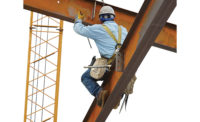Workplaces can sometimes be dangerous and that’s why OSHA requires employers to alert employees to hazards that they could encounter. A proactive way to provide this protection is to use the necessary signage, alarms, and signals to alert workers to these hazards.
Signs
OSHA requires different signs be used in different situations. Danger signs are to be used only where an immediate hazard exists that could present a threat of death or serious injury. An example would be a “High voltage” sign. Danger signs are to have red as the predominating color for the upper panel; black outline on the borders; and a white lower panel for additional sign wording.
Caution signs are to be used only to warn against potential hazards or to alert against unsafe practices. An example would be “Watch your step.” Caution signs have black upper panel and borders; yellow lettering of “caution” on the black panel; and the lower yellow panel for additional sign wording.
Safety instruction signs are used where there is a need for general instructions and suggestions relative to safety measures. An example would be “Eye protection required.” Safety instruction signs are white with a green upper panel and white letters to convey the principal message.
Employee alarms
Signals, better known as employee alarm systems, are used to provide employees with prompt warning of an emergency action. This alarm system must be addressed in the employer’s emergency action plan and should focus on the reaction time for safe escape of employees.
There are several requirements for the employee alarm system:
- It must be capable of being perceived above ambient noise (audible) or light levels (visual) by all employees in the affected portions of the workplace.
- Tactile devices may be used to alert those employees who wouldn’t otherwise be able to recognize the audible or visual alarm.
- It must be distinctive and recognizable as a signal to evacuate the area or to perform actions designated under the emergency action plan.
OSHA’s standards
General industry has its own requirements for signs in 1910 Subpart G at 1910.144 and 1910.145. These standards address the color and different types of signs.
Flagger signaling
Of all highway workers, flaggers are responsible for public safety and make the greatest number of contacts with the public. OSHA has specific requirements for flaggers at 1926.201.
Employee training
There are specific training requirements in both general industry and construction. General industry requirements are:
- All employees must be instructed that danger signs indicate immediate danger and that special precautions are necessary.
- All employees must be instructed that caution signs indicate a possible hazard against which proper precaution should be taken.
Construction’s requirements include:
- Explaining to each employee the preferred means of reporting emergencies, including manual pull box alarms, public address systems, or telephones.
- That flaggers must be trained in safe traffic control practices and public contact techniques.








.jpg?t=1721257160)
